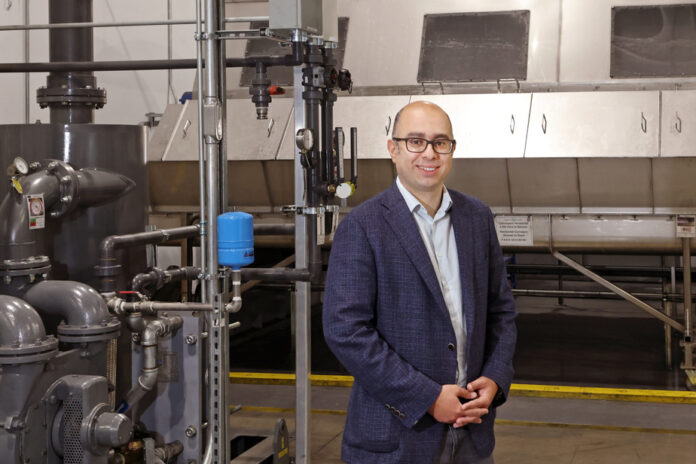Holder of a doctorate in nanotechnology from the University of Barcelona, Soroush Nazarpour came to Quebec in 2010 at the invitation of the National Institute for Scientific Research (INRS) to carry out postdoctoral work. The following year, he founded NanoXplore, which is today the world’s leading producer of graphene, the most advanced nanomaterial that is already used by several industries involved in the energy transition.
It was because his wife wanted to go and live in North America in a French-speaking community that Soroush Nazarpour accepted an offer from INRS in Varennes to come and do postdoctoral studies in nanotechnology.
“In 2010, two researchers from the University of Manchester were awarded the Nobel Prize in Physics for discovering graphene, a two-dimensional carbon crystal. All other materials have a three-dimensional structure.
“Graphene is unique and has unique properties. It’s the lightest material, has the highest conductivity – more than copper – and it’s 300 times stronger than steel,” Soroush Nazarpour tells me.
These unique attributes of graphene, which allow it to strengthen plastics and composite materials while reducing their weight, led the researcher to want to produce graphene powder on a large scale.
In 2011, he set up a research laboratory to test materials for different companies and developed his technology in parallel. An initial financing of $700,000 was made in 2014, then another of $2.5 million in 2015, which was followed by public financing of $10 million on the Toronto Growth Stock Exchange in 2017.
NanoXplore then manages to produce 25 tons of graphene per year before implementing its technology in 2020 in a new factory in Saint-Laurent capable of producing 4,000 tons of graphene per year on an industrial basis.
“We have obtained all the certifications for health and for the various industrial applications. We created the market and today we are the main producer with 40% of the world market”, underlines the CEO.
“Since our IPO, we have raised more than 150 million through private financing. The Caisse de depot et placement du Québec, Investissement Québec, BDC each took an 8% stake, Fidelity 6% and Martinrea, the third largest auto parts manufacturer in the world, took 23%. I kept an 8% stake in NanoXplore,” says Soroush Nazarpour.
The company expects to achieve revenues of 120 million for the current fiscal year and generate operating profits from the next year.
NanoXplore not only produces graphene, it also transforms it into composite materials for its various customers. It has acquired four factories in Beauce, in Saint-Éphrem and Sainte-Clothilde, which produce plastics and composites reinforced with graphene.
“Ford is a big customer. They use our materials to make part of the hood of their cars and for the brake and fuel lines.
“Our biggest customers are Paccar and Volvo. We even make entire pieces for Paccar with our own moulds. You can make A-grade surfaces that are 25% thinner. Paccar uses our composite materials to make the entire front of their trucks, hoods, cabins, bumpers…”, lists the CEO.
In addition to its four processing plants in Quebec, NanoXplore has two in Winnipeg, where it manufactures wind turbine components for General Electric, one in North Carolina for Volvo and Caterpillar, one in Ontario and finally one in Geneva where it manufactures high-precision parts that serve as much in cutting-edge watchmaking as in F1 engines!
The other growth vector that NanoXplore is developing is that of lithium-ion batteries for electric vehicles. The company has built a pilot plant in Dollard-des-Ormeaux for its VoltaXplore division with a capacity of 1 megawatt hour.
We are far from the 90 megawatt hours that Volkswagen will build in Ontario, but the VoltaXplore batteries are aimed at the high performance market such as super high-end cars or trucks and buses.
To support all these developments, the Saint-Laurent company is preparing to build a graphene plant in the northern crown of Montreal capable of manufacturing an additional 16,000 tons of graphene per year.
“Currently, we transform more than 70% of our graphene powder in our composite materials factories, but the industry is starting to want to manufacture its own parts in their facilities. We will therefore continue to transform while producing more pure graphene”, explains Soroush Nazarpour.
NanoXplore sources its graphite from Northern Graphite, but since its Lac-des-Îles deposit is on its last miles, the company could do business with Nouveau Monde Graphite.
“The government people would like us to invest in the exploitation of graphite deposits, but that would be too much. We don’t need to be more integrated,” the CEO points out.
How did a scientist like him hold all these simultaneous developments together in so few years?
Originally from Iran, Soroush Nazarpour was born and raised in Tehran before going on to postgraduate studies in Spain, but he started his first business at 14 and had several that were not always related to the technologies.
“I’ve always done business, it’s in my DNA. I have spoken to Minister Fitzgibbon on several occasions and he tells me all the time that I am the typical immigration candidate he wants for Quebec,” says the founder of NanoXplore with a smile.















